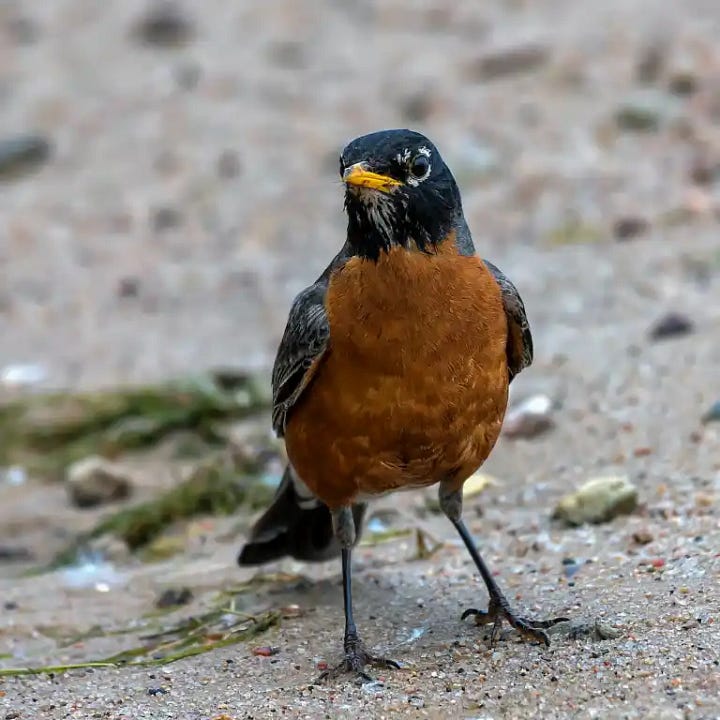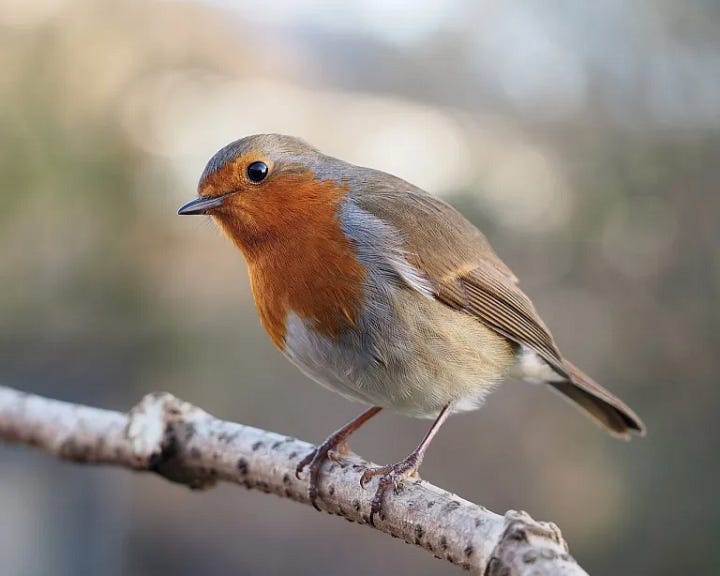How Robins Got Their Name
Growing up in eastern South Dakota, winters were harsh, dark, and long, often lasting until deep into April. Sometimes it would snow in May. While the first snow day was always a treat, by the time February rolled around, I was ready for winter to be over. At that time, I didn’t know the names of many background birds, but I could recognize a robin. I also knew, like every American schoolkid, to look out for the first robin of spring – seeing a robin meant that winter was at its end. Kids growing up in England are also more familiar with robins than probably any other bird. There, robins are year-round residents, but are most particularly associated with Christmas.


In both the United States and the United Kingdom, the robin is probably the most well-known and well-loved bird, by children and adults alike. Yet despite its popularity on both sides of the Atlantic, the robin of America and the robin of England are not the same bird. They’re not even closely related. In fact, if you travel to Australia, or India, or countries throughout Africa, you’ll find dozens of kinds of robins there too, which also have no relation to the American or English birds. This is the story of how all these robins ended up with the same name.
Robin Redbreast
During the 15th century, the English had an endearing practice of granting common human names to the birds that lived among them. Virtually every bird in that era had a name, and most of them, like Will Wagtail and Philip Sparrow have been long forgotten.[1] Polly Parrot has stuck around, and Tom Tit and Jenny Wren, personable companions of the English countryside, are names still sometimes found in children’s rhymes. Other human names, however, have been incorporated so durably into the common names that still grace birds as to almost entirely obscure their origin. The Magpie, a loquacious black and white bird with a penchant for snatching shiny objects, once bore the simple name “pie,” probably coming from its Roman name, “pica.” The English named these birds Margaret, which was then abbreviated to Maggie, and finally left at Mag Pie.[2] The vocal, crow-like bird called Jackdaw was also once just a “daw” named “Jack.”
The English also gave their ubiquitous and beloved orange-bellied, orb-shaped, wren-sized bird a human name. The first recorded Anglo-Saxon name for the Eurasian Robin was ruddoc, meaning “little red one.” By the medieval period, its name evolved to redbreast (the more accurate term orange only entered the English language when the fruit of the same name reached Great Britain in the 16th century). The English chose the satisfyingly alliterative name Robert for the redbreast, which they then changed to the popular Tudor nickname Robin. Soon enough, the name Robin Redbreast became so identified with the bird that Redbreast was dropped because it seemed so redundant.
The average resident of 17th or 18th century Great Britain would probably not be able to tell the difference between a Dunnock and a Chiffchaff, or point out a Pipit or Wagtail – all common birds throughout England. They would most certainly, however, recognize a Robin. Keith Thomas called the robin an “honorary pet,” as they had become nearly household birds given their inclination to visit towns and houses during the winter in search of food. These feisty and charismatic birds feature in many of the island’s folk tales, with the British seeing themselves represented in the tiny bird’s cheerful but pugnacious demeanor. Indeed, they are widely considered the country’s unofficial national bird. In 1815, the English poet William Wordsworth said as much in verse, writing:
“Art thou the bird whom man loves best,
The pious bird with the scarlet breast,
Our little English Robin?”
The American Robin
As English settlers began arriving in North America in the early 1600s, they made sense of their new world by giving names to the flora and fauna they encountered. Of course, American birds had names long before the English settlers arrived. Before it was called Robin, the bird was known as peyetchew by the Cree, opitcki by the Ojibwa, and pipitshi by the Nipissing.[3] But it was the rare explorer that bothered to learn these names – to the masses of European settlers arriving on America’s shores, it was as if they did not exist at all. Of the hundreds of birds native to North America, there is only one – the Sora, a diminutive hen-shaped marsh bird with a stubby yellow bill – whose English name originated from indigenous North American languages.[4] The rest had to settle for the duplicative and frequently inaccurate names carried over by the colonists.
English settlers were armed with both a limited understanding of speciation and diversity in the natural world, as well as a limited vocabulary for describing it. To the extent that they paid attention to the birds of their new home, these amateur ornithologists set about naming and describing birds from the list of categories at their disposal – which were the same words they used to describe and classify birds back in London or Liverpool. Sometimes the names they used were taxonomically correct – the mallards of Europe are the same as those of America, as are some swallows, ravens, and various types of owls, ducks, and shorebirds.
But there are many birds in North America that do not have close relatives in Europe. Regardless, English settlers continued applying the names of the birds they knew back home to the birds they encountered in their new land. And so, the most apt name in the English arsenal for the orange-breasted thrush abundant throughout America was Robin, even though the bird had twice the wingspan and four times the weight of the European flycatcher whose name it gained. These birds belonged to entirely different biological families – their ancestors parted ways about 17 million years ago, which is around the same time that our human ancestors split off from those of orangutans. And this wasn’t even the only bird to which the English applied the name Robin. Settlers liberally applied the term to any other songbird they encountered showing a hint of red or orange. At one time, Eastern Bluebirds, which have a band of orange on their chests, were also referred to as Robins. Eastern Towhees were called Ground Robins, while Baltimore Orioles were Golden Robins.[5] Nevertheless, the only bird to whom it stuck was our familiar Robin.
The English propagated the term Robin in the lands of their colonization as eagerly as they did the Monarchy or Christianity. In all the lands the English settled, some lucky bird sporting a red or russet color can still be found bearing the name robin. Over 100 birds carry the common name robin, including the Indian Robin, a widespread orange-rumped bird found across the Indian subcontinent; 14 species of ground robins and robin-chats found throughout Africa south of the Sahara; and an entire family of 49 Australasian robins throughout New Zealand, Australia, and Oceania. Few of these bear any close biological relationship to the Robin Redbreast of England.
With all of these robins, it can be easy to get them confused. And admittedly, knowing the difference between the American and European varieties is a piece of trivia likely only to matter to dedicated birders. But names also carry an outsized dose of history, and through them we can examine the relationship between people and the natural world. They also continue to reveal the legacy of European domination over indigenous peoples and the erasure of their knowledge.

[1] Thomas, Keith. Man and the Natural World: Changing Attitudes in England, 1500-1800. United Kingdom: Oxford University Press, 1983.
[2] “Magpie | Etymology, Origin and Meaning of Magpie by Etymonline.” n.d. Etymonline.
[3] Jess. 2021. “Indigenous Bird Names.” Avian Ecologist. October 26, 2021. https://www.avianecologist.com/2018/08/13/indigenous-bird-names-from-calls/.
[4] The Anhinga, a lithe, black waterbird with a snake-like neck and a needle for a beak whose range reaches from Uruguay to the American south, gets its name from the Tupi of Brazil who called them “snake bird” or “devil bird.”
[5] “How the Robin Got Its Name | BirdNote.” 2021. BirdNote. February 27, 2021.


Wagtail is derived from its active behaviour, while the origins of willie are obscure.
https://en.wikipedia.org/wiki/Willie_wagtail